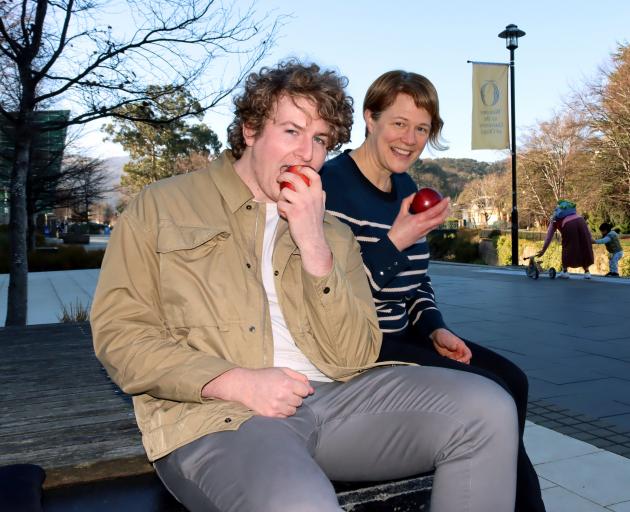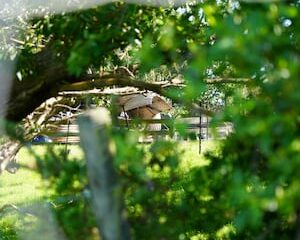Science
Research Unlocks Genetic Secrets of New Zealand’s Heritage Apples

A significant research initiative is underway to unlock the genetic secrets of over 300 apple varieties at the Jim Dunckley Heritage Orchard in New Zealand. Managed by the Coastal Otago Branch of the New Zealand Tree Crops Association, this orchard is recognized for its diverse collection of apple cultivars, including uniquely named varieties like Peasgood Nonsuch, Nonnetit Bastard, and Warner’s King.
Aaron Hewson, a master of science student specializing in plant biotechnology, is leading this important research. His work aims to provide genetic identification for the orchard’s heritage cultivars, ensuring their preservation and propagation. “I am doing this research for them so they can continue to preserve and propagate the heritage cultivars, with confident identification by genetic means,” Hewson stated.
Established around 25 years ago, the orchard contains a rich variety of apple cultivars collected by Jim Dunckley from various locations across Otago and Southland. Most of these cultivars were sourced from Clyde, where an old Plant & Food Research orchard was located. Hewson described the collection as “a real kind of hodgepodge mix,” noting that some trees have names given by local farmers that reference nearby landmarks.
These names do not always align with the genetic identities of the apples. “There is one case where we had a Plant & Food apple called Granny Smith, the classic one you get in supermarkets, and another one called Lord Lambourne,” Hewson explained. “These two cultivars should be really different, but the samples were saying they were genetically the same. So one of those names has to be wrong.”
To clarify these discrepancies, samples were collected from the orchard by university students and staff from the Plant Biochemistry Lab. After being labeled and freeze-dried, the samples were sent to a laboratory in France for genetic analysis, facilitated by Plant & Food Research, now part of the Bioeconomy Science Institute.
Hewson credits his co-supervisor, Dr. Elena Lopez-Girona from Plant & Food Research, for her support throughout the process. “It has been very beneficial to have her expertise,” he stated. The laboratory utilized a method known as SNP chip analysis, which examines approximately 50,000 DNA hotspots in an apple leaf to create a genetic fingerprint. This technology allows researchers to determine whether two trees belong to the same variety or are genetically distinct.
The need for this research is underscored by stringent biosecurity regulations that hinder the importation of new apple genetics. As a result, the local collection could be essential for identifying disease resistance and other advantageous traits. “If we talk about the entire amount of apples across the world, there is something on the order of 10,000 different varieties. But all of our commercial varieties, no matter how many there are, they all come from six apples, so it is really, really narrow,” Hewson pointed out.
Associate Professor Lynnette Brownfield from the University of Otago, who also supervises Hewson, emphasized the importance of this research. She noted that the narrow genetic base of commercial apples in New Zealand creates a need for identifying the genetic diversity within the orchard. This knowledge could assist breeders in discovering new genetic material, including traits that confer disease resistance, thereby broadening future breeding options.
The Coastal Otago Branch of the New Zealand Tree Crops Association, which owns the orchard, will ultimately decide how to utilize the findings from this research. Professor Brownfield highlighted the goal of assigning unique IDs to all trees in the collection. This identification will facilitate communication with apple breeders, ranging from backyard enthusiasts to organizations like Plant & Food Research, and enable the provision of germplasm as needed.
The ongoing genetic research at the Jim Dunckley Heritage Orchard not only aims to preserve New Zealand’s apple heritage but also seeks to enhance the genetic diversity available for future apple breeding efforts. As this project progresses, it holds the potential to influence the future of apple cultivation in the region and beyond.
-

 World1 week ago
World1 week agoPrivate Funeral Held for Dean Field and His Three Children
-

 Top Stories2 weeks ago
Top Stories2 weeks agoFuneral Planned for Field Siblings After Tragic House Fire
-

 Sports3 months ago
Sports3 months agoNetball New Zealand Stands Down Dame Noeline Taurua for Series
-

 Entertainment3 months ago
Entertainment3 months agoTributes Pour In for Lachlan Rofe, Reality Star, Dead at 47
-

 Entertainment2 months ago
Entertainment2 months agoNew ‘Maverick’ Chaser Joins Beat the Chasers Season Finale
-

 Sports3 months ago
Sports3 months agoSilver Ferns Legend Laura Langman Criticizes Team’s Attitude
-

 Sports1 month ago
Sports1 month agoEli Katoa Rushed to Hospital After Sideline Incident During Match
-

 World2 weeks ago
World2 weeks agoInvestigation Underway in Tragic Sanson House Fire Involving Family
-

 Politics2 months ago
Politics2 months agoNetball NZ Calls for Respect Amid Dame Taurua’s Standoff
-

 Top Stories2 weeks ago
Top Stories2 weeks agoShock and Grief Follow Tragic Family Deaths in New Zealand
-

 Entertainment3 months ago
Entertainment3 months agoKhloe Kardashian Embraces Innovative Stem Cell Therapy in Mexico
-

 World4 months ago
World4 months agoPolice Arrest Multiple Individuals During Funeral for Zain Taikato-Fox





















